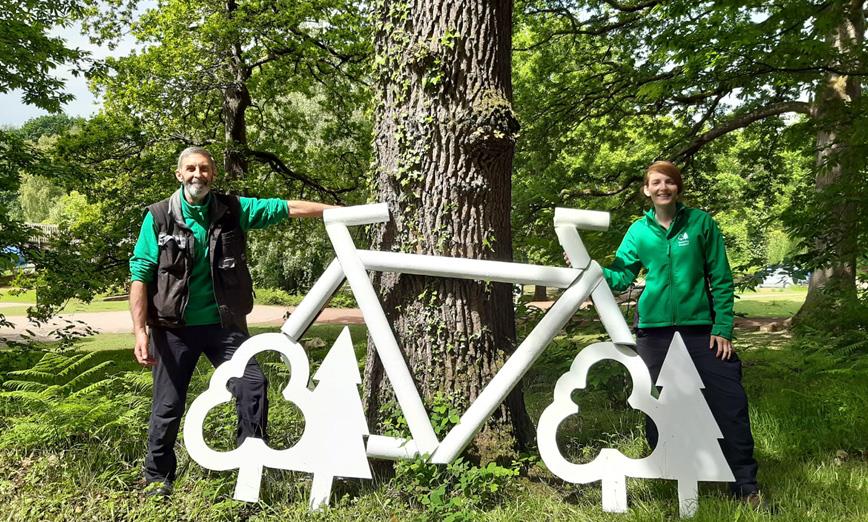- Stay
- What's On
- Things To Do
- Food & Drink
- Explore
- Inspiration
- Offers
- Weddings
- Blog
My Planner
- Stay
- What's On
- Things To Do
- Food & Drink
- Explore
- Inspiration
- Offers
- Weddings
- Blog
You are here: Explore > History & Heritage > Myths and Legends > Myths & Legends of the Forest of Dean
Discover the myths and legends of the Forest of Dean from the age old question of ‘who killed the bears?’ to the mysterious bleeding stone.
Who Killed the Bears…?
In the 1800s, two Russian bears were brought to the Forest of Dean by some Frenchmen. While en route to Ruardean, an angry mob started to chase them and launched a deadly attack on the bears and beat up the owners. During this time, it was a common myth that Foreign bear-keepers fed their animals on local children’s flesh.
However, some Ruardean residents witnessed the brutal attack and went to shelter the injured. The assailants were later fined for their unfounded attack but during the legal process the attackers were thought to be described as residents of Ruardean when really they went to help in the aftermath of the attack. The mocking refrain “Who killed the bears?” still taunts the residents of Ruardean to this day…
The Bleeding Stone
The Staunton Longstone is a Bronze Age standing stone that stands at seven feet tall. Local folklore says that the stone will bleed if it’s pricked with a pin at precisely midnight…
Littledean Hall
Littledean Hall is a country house in the village of Littledean. It is reputedly one of the most haunted houses in England. It is known for its phantom blood stains and the ghostly manservant of Charles Pyrke of Littledean Hall.
The alleged murder of Charles Pyrke by his manservant is said to have something to do with a black baby that was born in the house. The baby was concealed behind the secret panel in the Oak or Blue bedroom and one story suggests that the baby was born to the manservants sister which led to him taking revenge on Charles Pyrke. Another story claims it was Charles who murdered his servant, which seemed unlikely. Allegedly a Gloucester newspaper reported that a black man with a silver collar was found straying in the district after Charles’s murder and it was thought that it was the guilty servant.
The black boy is said to haunt the 1st floor landing with a candle in his hand as well as other poltergeist activity such as throwing red and white flowers onto the floor in the old dining room at night time.
The Last Witch of Gloucestershire?
A Cinderford wise woman, Ellen Hayward was the last person charged with Witchcraft in Gloucestershire. She was tried at Littledean Jail in 1906.
The Beast of the Dean
There have been many, historical and more recent reports of mysterious creatures living in the woods especially around Parkend. One notable example is the ‘The Beast of Dean’ which was also given the name ‘Moose-Pig’. Long before reintroduction of wild boar in the area, an animal said to resemble a boar but large enough to crush hedges and make trees fall lurked in the depths of the woods.
Lydney Park Roman Temple Curse
One of the artefacts found at the Lydney Park Roman Temple Site was a cursed tablet. The tablet read ” o the God Nodens. Silvanus has lost a ring. He has [vowed] half its value to Nodens. Amongst all who bear the name of Senicianus, refuse thou to grant health to exist, until he bring back the ring to the Temple of Nodens.”
Extraordinarily, the exact ring was found in a farmer’s field in Hampshire. The ring itself is now housed in The Vyne Museum, it also lives with lots of Tolkien memorabilia and the question remains as to whether or not the ancient ring was the very one that inspired J.R.R Tolkien to write the famous Lord of the Rings series.
Parkend Rune Stone
In St Paul’s graveyard, there is the Parkend Rune Stone. It’s a gravestone dedicated to Edmund Vimpany, who died in 1836. Two sides of the stone contain a mysterious Runic inscription which has never been deciphered, despite many attempts. Some of the Runic letters are familiar, yet some seem to have been manoeuvred.
Many people often wonder whether it is a secret code or whether it is just a practical joke played upon future generations by a dead man.
The Dymock Curse
An inscribed lead tablet was found in a house in Wilton Place, Dymock. The name Sarah Ellis was written backwards at the top and there were also inscriptions on the tablet representing good and evil spirits, there is also a curse written on the tablet. Sarah Ellis was never found and the local legend is that the curse affected her so much that she committed suicide. The tablet is now displayed in Gloucester Folk Museum.
King Caractacus
Around 47A.D. it is said that Ostorius Scapula crossed the River Severn with his army and defeated King Caratacus in a battle near Newnham. The Romans chased King Caratacus to the hilltop of Dean’s Hill where the Roman army allegedly made camp in the grounds of Dean Hall, had tea and raised a monument to Victory.
Defeated, Caratacus and his remnant army disappeared into the woods and travelled west.
Sabrina, Goddess of the River Severn
According to mythology the River Severn is said to have a goddess named Sabrina.
King Locrinus, one of the sons of the Trojan Brutus once led an army to the north of England and fell in love with a German prisoner called Estrildis, although Locrinus had promised marriage to Gwendolen, daughter of Brutus’s second-in-command, Corineus.
Hearing the news of Locrinus’s other love, Corineus, forced Locrinus to marry Gwendolen. The King agreed but kept Estrildis as a mistress in an underground dwelling for many years. He pretended to make sacrifices to the gods, but instead was visiting his lover, after time she fell pregnant and gave birth to a daughter by the name of Habren.
When his wife’s father died, Locrinus took the opportunity to finally leave Gwendolen and marry his true love and mother of his daughter, Estrildis. Enraged, Gwendolen killed her former husband near the Severn tributary that joins the Severn at Stourport and ordered that his mistress, Estrildis and daughter, Habren be put to death by being drowned in the River Severn.
To remember the poor child Habren, Gwendolen suggested that the river should bear the child’s name – Habren or Hafren in Welsh, Severn in English, and Sabrina in Latin and is often known as the Goddess of the River Severn.
Supposedly a temple belonging to Sabrina stood at the hilltop at Littledean and in 1984 Donald Macer-Wright discovered the remains and it was identified by the late Professor Barri Jones as a Roman Water Shrine.
Dick Whittington
Sir Richard Whittington who lived from 1354 – 1423 was a merchant politician and was Lord Mayor and Benefactor of the City of London four times. He was the youngest son of Sir William Whittington, who was Lord of the Manor of Pauntley located in the Forest of Dean, Gloucestershire.
Unfortunately, Sir William fell out with authority and was ‘outlawed’ by the King for a reason that remains unknown, but a heavy fine was paid for the ‘inlawry’ of the family.
After the death of Sir William, Richard’s mother remarried and his eldest brother inherited the estate. Richard had no income, so he travelled to London to learn the trade of ‘Mercer’. He became a successful trader who imported silks and velvets and exported English woollen cloth called Broadcloth to Europe. From 1392 – 94, Richard sold goods to King Richard II that would be worth £1.5 million in today’s money and he was also a money lender and property buyer.
Sir Richard Whittington became a character in a story adapted for the stage as a play “The History of Richard Whittington, of his low byrth, his great fortune” in 1604. Various versions of his story were published and in the 19th century, it became a popular pantomime for families to enjoy during the Christmas season called ‘Dick Whittington’.
 Supported by the Forest of Dean District Council’s Economic Growth Fund
Supported by the Forest of Dean District Council’s Economic Growth Fund
©Visit Dean Wye 2025. All Rights Reserved.
*Visit Dean Wye is the trading name of Forest of Dean & Wye Valley Tourism Limited.







